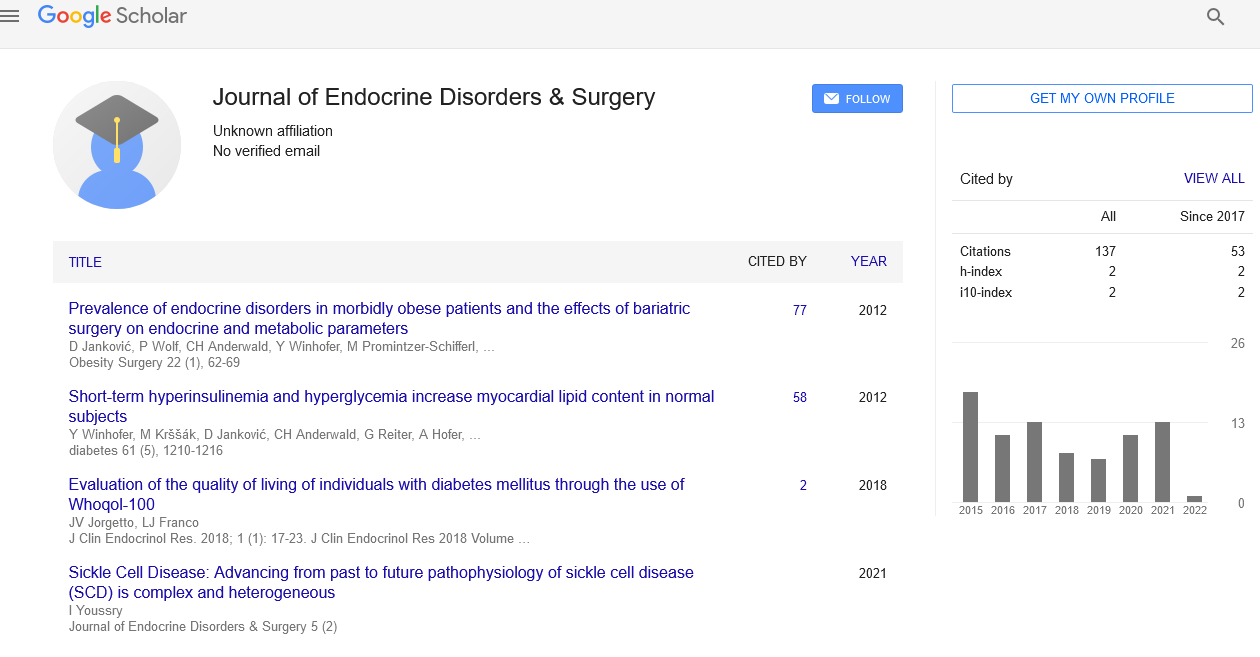Adrenal disorders
Received: 04-Oct-2022, Manuscript No. PULJEDS-23-6205 ; Editor assigned: 04-Oct-2022, Pre QC No. PULJEDS-23-6205 (PQ); Accepted Date: Oct 25, 2022; Reviewed: 10-Oct-2022 QC No. PULJEDS-23-6205 (Q); Revised: 12-Oct-2022, Manuscript No. PULJEDS-23-6205 (R); Published: 30-Oct-2022, DOI: 10.37532/puljds.2022.6(5).01-02
Citation: James A. Adrenal Disorders. J. Endocr Disord Surg. 2022; 6(5):01-02
This open-access article is distributed under the terms of the Creative Commons Attribution Non-Commercial License (CC BY-NC) (http://creativecommons.org/licenses/by-nc/4.0/), which permits reuse, distribution and reproduction of the article, provided that the original work is properly cited and the reuse is restricted to noncommercial purposes. For commercial reuse, contact reprints@pulsus.com
Abstract
The tiny, triangular-shaped adrenal glands are found just above each kidney. They are referred to as suprarenal glands at times. Their function is to produce the hormones required to maintain the proper functioning of your immune system, metabolism, blood pressure, and stress reaction. The gland’s over or underproduction of particular chemicals leads to adrenal disorders. The adrenal glands generate the hormones hydrocortisone, adrenaline, and aldosterone.
Keywords
Aldosterone; Hydrocortisone; Adrenaline
Introduction
The mature adrenal cortex contains progenitor and/or stem cell populations that allow cortical cells to experience homeostatic renewal and regeneration after damage. Although newly formed cells go through centripetal migration, differentiation, and lineage conversion in the process of creating the various functional steroidogenic zones, renewal primarily takes place in the outer layers of the adrenal gland. Adrenal gland disorders are conditions interfering with the two adrenal glands that produce several important hormones, thus affecting bodily functions such as blood pressure, development and weight. Disorders of the adrenal gland can interfere with how individuals develop sexually and how women carry on pregnancies. Some diseases of the adrenal glands are congenital (inherited), while others are brought on by immune disorders, infections, tumors, or stress. Some diseases of the adrenal gland can be medicated by doctors. Surgery is required for the treatment of additional adrenal gland diseases.
The adrenal glands are endocrine (hormone) glands that are situated close to the apex of each kidney. Adrenal gland disorders can interfere with a number of vital bodily processes. The hormones produced by the glands regulate the body's "fight or flight" instinct, which is the physiological response to a sensed attack or health danger. These chemicals also control how the body works. Blood pressure, heart rate, sweating, and the production of the sex hormones testosterone and estrogen are just a few of the adrenalrelated processes that can be impacted by disorders of the adrenal glands. They also aid in controlling how the body utilizes potassium and sodium, as well as how people's bodies develop sexually and support pregnancy
The adrenal glands can be impacted by a variety of medical problems. These include elevated blood pressure brought on by the overproduction of aldosterone as well as Addison's disease, Cushing's syndrome, and adrenal cancer.
Adrenal Gland Hormones
The cortex and the medulla are the two components of the adrenal glands. The cortex is the gland's top layer. Aldosterone and cortisol are produced by it. The innermost region of the organ is called the medulla. The chemicals noradrenaline and adrenaline are produced by it. These four hormones are necessary for the body to operate normally. They are in charge of numerous crucial operations, including:
• Metabolism
• Blood sugar levels
• Blood pressure
• Salt and water balance
• Pregnancy
• Sexual development before and during puberty
• Stress response
• The balance of sex hormones, including estrogen and testosterone
Adrenal Insufficiency
Adrenal insufficiency is the condition in which there is insufficient cortisol production by the adrenal glands. Three conditions result in adrenal insufficiency.
• Primary adrenal insufficiency, or Addison’s disease
• Secondary adrenal insufficiency
• Tertiary adrenal insufficiency
According to the National Institute of Diabetes and Digestive and Kidney autoimmune illness is the primary cause of Addison's disease. Having injured adrenal glands at birth, having a condition that impairs immunity, like HIV or AIDS, taking corticosteroids for a long time and then abruptly stopping, having tumors on the adrenal glands or those that interact with the adrenal glands, tuberculosis, cancer in the adrenal glands, and traumatic brain injury.
Aldosterone and cortisol deficiencies are common in people with Addison's syndrome. Adrenal insufficiency signs can be challenging to identify. They may develop gradually, leading one to believe that another factor is to blame. The most typical warning indications and symptoms are:
• Always feeling tired or weak
• Unexplained weight loss
• Loss of appetite
• Nausea or vomiting
• Diarrhea
• Dizziness or fainting when standing up
• Low blood pressure
• Low blood glucose
Congenital adrenal hyperplasia (CAH) is inherited due to a genetic difference. This implies that they will be born with it. However, the signs might not be immediately apparent. An individual with CAH lacks the necessary enzymes to produce the hormone cortisol. They might therefore have very little or no cortisol. Numerous CAH sufferers also have low amounts of aldosterone.





